Abstract
Global climate change is likely to increase the risk of frequent drought. Maize, as the principal global cereal, is particularly impacted by drought. Nutrient supply may improve plant drought tolerance for better plant establishment during seedling growth stages. Thus, this study investigated the interactive effects of drought and the application of the nutrients N, P and K either individually or in combination. The maize seedlings were harvested between 12 and 20 days after sowing, and the leaf area, shoot fresh and dry weight and root dry weight were determined, and shoot water content and root/shoot dry weight ratio were calculated. Among the N, P and K fertilization treatments applied individually or in combination, the results showed that there was generally a positive effect of combined NPK and/or NP nutrient supply on shoot growth such as leaf area, shoot fresh and dry weight at day 20 after sowing under both well-watered and drought conditions compared with no nutrient supply. Compared with the effect of N and P nutrient supply, it seems that K was not limiting to plant growth due to the mineralogical characteristics of the illitic-chloritic silt loam used, which provided sufficient K, even though soil tests showed a low K nutrient status. Interestingly, the root/shoot ratio remained high and constant under drought regardless of NPK application, while it decreased with NPK applications in the well-watered treatment. This suggests that the higher root/shoot ratios with N, NP, PK and NPK under drought could be exploited as a strategy for stress tolerance in crop plants.
1. Introduction
Drought is a primary constraint to global crop production, and global climate change is likely to increase the risk of frequent drought, especially in rain-fed agriculture [1,2]. Maize, as the principal global cereal, is particularly impacted by frequent drought spells. Under drought stress, reduced nutrient availability is one of the most important factors limiting plant growth [3]. Drought reduces nutrient uptake by the roots, in part, because the decline in soil moisture results in a decreased rate of diffusion of nutrients from the soil matrix to the absorbing root surface [3,4,5]. Moreover, nutrient transport from the roots to the shoots is also restricted by reduced transpiration rates and impaired active transport and membrane permeability, together resulting in a reduced root absorbing power by crop plants [6,7]. Thus, nutrient supply strongly affects crop productivity under drought conditions, but this is also very complex [8,9,10]. The positive effects of N and P on plant growth under drought conditions are attributed to an increase in water-use efficiency, stomatal conductance [11,12,13,14], photosynthesis and ATPase activity [5,15], as well as higher cell membrane stability and improved osmotic adjustment [16,17]. However, K increases a plant′s drought tolerance through its functions in stomatal regulation, energy status, charge balance, protein synthesis and homeostasis [18,19,20]. Many physiological mechanisms are involved in the improvement of plant growth through nutrient supply. However, the different studies on the benefit of N, P and K fertilization on plant growth under drought stress are controversial [14,21,22]. Thus, it is necessary to compare the effect of a single nutrient supply, such as N, P and K, and/or combined nutrients on plant growth within the same experiment.
Maize growth is most sensitive to drought during the early growth stages [23,24,25,26,27,28,29,30]. At seedling growth stages, maize growth is characterized by leaf initiation and elongation and by changes in relative root growth maintenance and root architecture [31,32]. Such growth processes react sensitively to drought [31,33,34,35,36]. In addition, the seedling growth stage of maize is highly relevant for P deficiency, since most P-deficiencies in maize are often observed in western Europe at an early growth stage, which has been shown in long-term experimentation [37]. Therefore, it is important to understand how nutrient supply can maintain shoot and root growth, especially during the early growth of plants under drought stress.
The objective of this study was to investigate the interactive effects of different N-, P- and K-nutrition supplementations singly and in combination, as well as the effect of drought stress on shoot and root development of young maize plants, and to understand the different sensitivities of root and shoot growth to drought stress during the early growth stages under different nutrient supplies.
2. Materials and Methods
2.1. Plant Materials and Growth Conditions
Maize seeds (Zea mays L. cv Issa), pre-germinated for one day in distilled water, were sown in a pot (10.5 cm in diameter and 20 cm tall), containing 1.5 L of silty soil. The wetted soil was mixed thoroughly and allowed to equilibrate for more than two days. Thereafter, the soil was sieved and filled into the pots. To minimize water loss through evaporation, a 2-cm layer of quartz sand (ϕ = 2 mm) covered the soil surface. Four days after sowing, the seedlings were thinned from four to three plants per pot. There were 3 pots per treatment, i.e., all treatments were replicated three times. The properties of the soil are shown in Table 1 [38]. The nitrate, P, K and Mg contents of the soil were determined in NH4-acetate-EDTA extracts before the experiment started (Table 2). For the nutrient treatments, modified Hoagland’s nutrient solution was added to the dry soil to obtain the following: (a) a gravimetric soil water content of 27% and (b) eight nutrient treatments, i.e., no nutrients (control), single nutrient treatments consisting of N, P and K and combined nutrient treatments consisting of NP, NK, PK and NPK. The soil nutrient status in the different treatments is presented in Table 2. The experiment was conducted in a growth chamber with a 12 h photoperiod. The photosynthetic photon flux density (PPFD) was approximately 450 μmol m−2 s−1. The air temperature was 20/18 °C day/night and the relative humidity was maintained at 50–65%.

Table 1.
Soil characteristics (CEC: cation exchange capacity).

Table 2.
Composition of the different levels of the NPK nutrients based on an EDTA extraction for the well-watered and drought treatments.
The soil moisture content in all treatments was maintained at the initial content by adding tap water until day 10 after sowing. Then, the soil water content for the well-watered treatments (half of the pots) was continually maintained at the initial water content by adding tap water daily. The drought treatments for the other half of pots were obtained by drying the soil out without further watering.
During the experiment, pots were weighed daily before watering. The bulk soil water content was determined from gravimetric measurements of the pots (plant weight was estimated and considered in the calculations). At each harvest, the soil water content was determined gravimetrically using soil samples (mixed samples from the whole soil volume). Soil matric potential was calculated using a soil retention curve that was previously established (data not shown) and is presented in Table 3.

Table 3.
Bulk soil matric potentials in pots of the different nutrient treatments on different harvest days.
2.2. Determination of the Leaf Area, the Shoot and Root Biomass and the Shoot Water Content
The maize plants were harvested on days 12, 14, 16, 18 and 20 after sowing. At each harvest date, the leaf area was measured with a leaf area meter (accuracy: ±2%) (LI-300A, Bioscienses, Lincoln, Nebraska, USA). The shoot fresh weight (FW) was weighed using a balance (accuracy: 0.01 g) (Sartorius AG, Goettingen, Germany), and then the shoots were dried in an oven for 24 h for the determination of the dry weight (DW). The roots were washed on a sieve and were subsequently dried in an oven for 24 h for the determination of the DW. The root/shoot ratios, based on the shoot and root DW, were calculated. The shoot water content was calculated from the shoot FW and DW using the equation: WC (%) = (FW − DW)/FW.
2.3. Statistical Analysis of the Data
A randomized complete design was used. The data were analysed by an analysis of variance (ANOVA) using SAS (SAS, Institute Inc., Cary, NC, USA) to test the significance of the main effects. Duncan’s test was applied for the post hoc multiple comparisons within the well-watered or drought treatment. The terms were considered to be significant at nominal p < 0.05.
3. Results
3.1. Analysis of Variance (ANOVA)
The results from the analysis of variance (Table 4, Table 5 and Table 6) show that the single and combined nutrient treatments were significant as main effect in the ANOVAs, while the water supply was significant as a main effect for leaf area, whole plant DW, shoot water content, root DW and root/shoot ratio at day 20 after sowing and for shoot FW at days 18 and 20 after sowing. An interaction between nutrient treatments and soil water conditions was found for the shoot water content, root/shoot ratio (p < 0.001) and shoot FW (p < 0.01) at day 20 after sowing (Table 4).

Table 4.
Analysis of variance (ANOVA) results for leaf area, whole plant dry weight (DW), shoot water content (WC), root dry weight (DW) and root/shoot DW ratios at day 20 after sowing.

Table 5.
Analysis of variance (ANOVA) results for shoot fresh weight (FW) at days 12, 14, 16, 18 and 20 after sowing.

Table 6.
Analysis of variance (ANOVA) results for shoot dry weight (DW) at days of 12, 14, 16, 18 and 20.
3.2. Interactive Effects of NPK Nutrients and Drought on the Total Plant Dry Weight and Leaf Area of Maize Seedlings
Compared to the control treatment (without nutrient supply), the leaf area of the maize seedlings under both drought and well-watered conditions was significantly increased with the supplementation of NP and NPK (Figure 1). However, nitrogen supply only significantly enhanced leaf area under well-watered conditions. The results in Figure 1 also show a significant difference between the drought and well-watered conditions with single N and combined NP and NPK fertilization at day 20 after sowing.
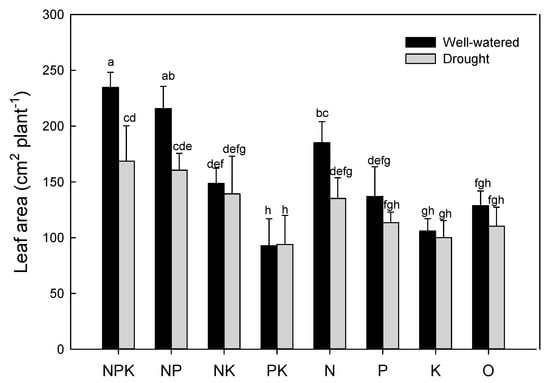
Figure 1.
Interactive effects of drought and the N, P and K nutrients applied individually or in combination, or with no nutrient application (0) on the leaf area of the maize seedlings at day 20 after sowing. The error bars represent the standard errors of the mean (n = 3) and fit within the plot symbol if not visible. Means accompanied by different letters are significantly different at p < 0.05.
Figure 2 presents the interactive effects of drought and nutrients on the total plant dry weight (DW) of the maize seedlings (shoot DW + root DW) at day 20 after sowing. The NPK supply significantly enhanced the total dry weight under well-watered conditions, and the NP and NPK significantly increased the total dry weight under drought compared with the no nutrient supply condition. In contrast to leaf area, there was no significant difference in the total plant DW between well-watered and drought conditions regardless of nutrient treatment.
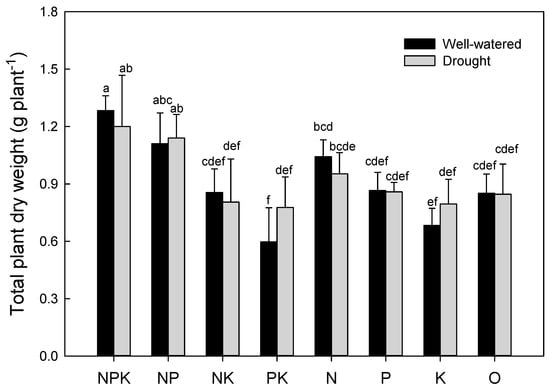
Figure 2.
Interactive effects of drought and the N, P and K nutrients applied individually or in combination, or with no nutrient application (0) on the total dry weight (shoots + roots) of the maize seedlings at day 20 after sowing. The error bars represent the standard errors of the mean (n = 3) and fit within the plot symbol if not visible. Means accompanied by different letters are significantly different at p < 0.05.
3.3. Interactive Effects of NPK Nutrients and Drought on the Fresh and Dry Weights of the Shoots and the Water Content of the Maize Seedlings
Figure 3 and Figure 4 reveal different effects of the nutrient supply on the development of the shoot FW and DW of the maize seedlings under both the drought and well-watered conditions. At day 12 after sowing, the results in Figure 3 show that NPK fertilization already significantly increased shoot FW compared with no nutrient supply. At day 20 after sowing, the shoot FW was significantly enhanced by N, NP and NPK in the well-watered treatments and NP and NPK in the drought treatment compared with no nutrient supply. A significant difference between well-watered and drought conditions was found for the nutrient supply with NP and NPK at day 18 after sowing and N, NP and NPK at day 20 after sowing.
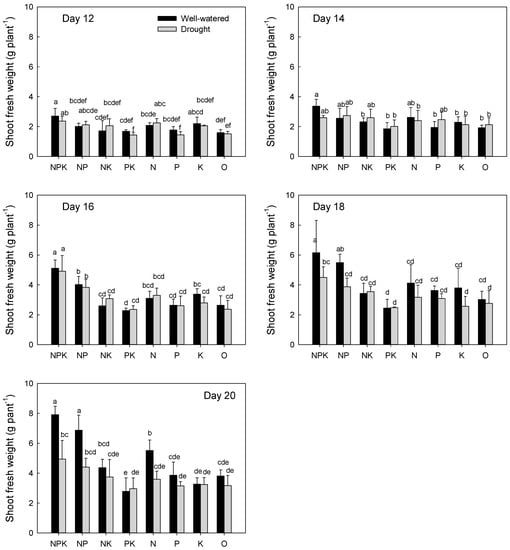
Figure 3.
Interactive effects of drought and the N, P and K nutrients applied individually or in combination, or with no nutrient application (0) on the shoot fresh weight of the maize seedlings at days 12, 14, 16, 18 and 20 after sowing. The error bars represent the standard errors of the mean (n = 3) and fit within the plot symbol if not visible. Means accompanied by different letters are significantly different at p < 0.05.
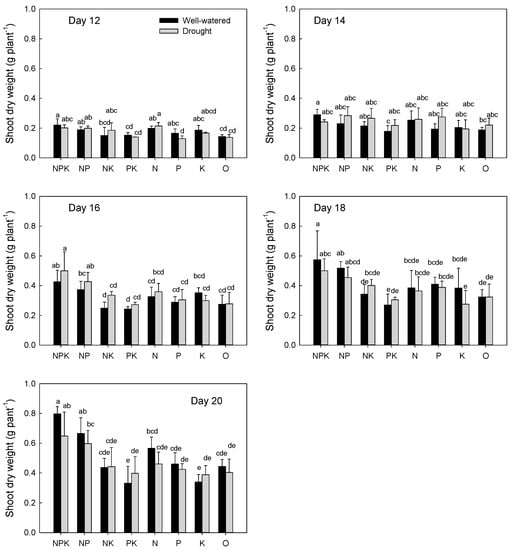
Figure 4.
Interactive effects of drought and the N, P and K nutrients applied individually or in combination, or with no nutrient application (0) on the shoot dry weight of the maize seedlings at days 12, 14, 16, 18 and 20 after sowing. The error bars represent the standard errors of the mean (n = 3) and fit within the plot symbol if not visible. Means accompanied by different letters are significantly different at p < 0.05.
Although N, NP and NPK fertilization significantly increased shoot DW at day 12 after sowing for the well-watered treatment and N and NP nutrient supply for the drought treatment compared with no nutrient supply (Figure 4), the effect of nutrient supply individually and in combination on the shoot DW under both well-watered and drought conditions was not consistent between day 12 and day 20 after sowing. At day 20, the NP and NPK fertilization significantly increased shoot DW for both well-watered and drought conditions compared with no nutrient supply. In contrast to shoot FW, there was no significant difference in shoot DW between well-watered and drought treatments regardless of harvest time (Figure 4).
Nutrient supply increased shoot water content compared with no nutrient supply treatment, especially under well-watered conditions (Figure 5). For example, except for P and PK, N, K, NP, NK, NPK fertilization significantly increased the shoot water content compared with no nutrient supply under well-watered conditions, whereas, under drought stress, a significant increase in shoot water content was found for K, NK and NP treatments. The shoot water content was significantly reduced by drought stress for all nutrient treatments (Figure 5).
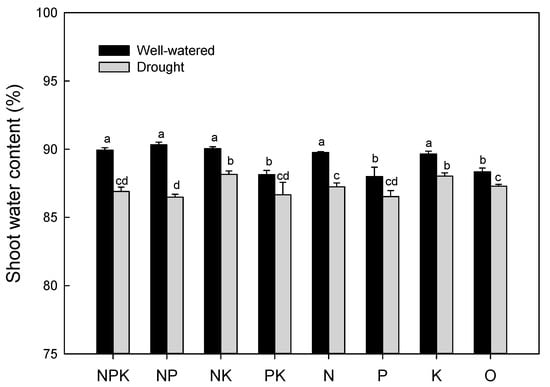
Figure 5.
Interactive effects of drought and the N, P and K nutrients applied individually or in combination, or with no nutrient application (0) on the shoot water content of the maize seedlings at day 20 after sowing. The error bars represent the standard errors of the mean (n = 3) and fit within the plot symbol if not visible. Means accompanied by different letters are significantly different at p < 0.05.
3.4. Interactive Effects of NPK Nutrients and Drought on the Root Dry Weight and Root/Shoot Dry Weight Ratios of the Maize Seedlings
Compared with no nutrient supply treatments, there was no significant change in root DW with N, P individually and NP, NK and NPK in combination (Figure 6). Similar to the effect of drought on the shoot DW, there was no significant effect of drought on the root DW at day 20 after sowing for all other nutrient treatments except NK supply.
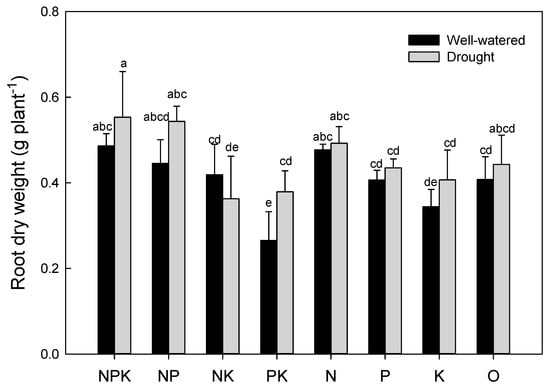
Figure 6.
Interactive effects of drought and the N, P and K nutrients applied individually or in combination, or with no nutrient application (0) on the root dry weight of the maize seedlings at day 20 after sowing. The error bars represent the standard errors of the mean (n= 3) and fit within the plot symbol if not visible. Means accompanied by different letters are significantly different at p < 0.05.
Compared with no nutrient supply treatments, the root/shoot DW ratio tended to be reduced by nutrient supply under well-watered conditions and to remain unchanged under drought conditions. However, a significant decrease in the root/shoot DW ratio was found in response to NP and NPK under well-watered conditions and NK and NPK under drought stress compared with no nutrient supply (Figure 7). Drought enhanced the root/shoot DW ratio at day 20 after sowing for all other nutrient treatments except NK supply. A significant increase in the root/shoot DW ratio under drought was found with N, NP, PK and NPK fertilization (Figure 7).

Figure 7.
Interactive effects of drought and the N, P and K nutrients applied individually or in combination, or with no nutrient application (0) on the root/shoot dry weight ratios of the maize seedlings at day 20 after sowing. The error bars represent the standard errors of the mean (n = 3) and fit within the plot symbol if not visible. Means accompanied by different letters are significantly different at p < 0.05.
4. Discussion
The results in this study showed that there was generally a positive effect of combined NPK and/or NP nutrient supply on shoot growth, such as leaf area, shoot FW and DW at day 20 after sowing, not only under well-watered conditions, but also under drought compared with no nutrient supply treatment (Figure 1, Figure 3 and Figure 4). Nitrogen, P and K are the major nutrients required for plant growth. According to Liebig′s law of the minimum [4], any nutrient at a limiting concentration in soil will inhibit plant growth. Compared with N and P nutrient supply, it seems that K was not limiting to plant growth in this study. This might be because the mineralogical characteristics of the illitic-chloritic silt loam (fine mixed mesic Aquic Ustifluvent [32]) used in this investigation makes it plausible that a sufficient supply is still rendered possible without further K supply. This might indicate that current soil test methods used do not adequately indicate the soil nutrient supply for the given soil. Optimal nutrient levels of fertilization are even more important under water deficit conditions, since reduced nutrient availability is one of the major factors limiting plant growth under drought [5,9,14]. To our knowledge, this is the first report of a comparison of maize seedling growth with N, P and K nutrient application individually or in combination under drought and well-watered conditions. Thus, the results here may suggest that supplying nutrients under deficient conditions could increase the drought tolerance of plants by increasing plant biomass for early growth vigour and establishment, which is in agreement with reports from the literature [9,10,31,34,35]. According to the literature [9], however, caution should be taken when considering an increase in the supply of nutrients to alleviate the adverse effects of drought stress only if the nutrient is present in the soil in insufficient amounts and the drought stress is not severe. The positive effects of nutrients on plant growth under drought conditions can be explained by their physiological functions. For example, such positive effects of N and P are attributed to an increase in photosynthesis [15], stomatal conductance and water-use efficiency [11] and higher cell membrane stability and osmotic adjustment [16]. Nitrogen fertilization, particularly using nitrate [12], regulates water flux through plants by N-flux-linked signalling mechanisms [39,40,41]. In most cases, the reports in the literature show that an improved K nutritional status in plants is of great importance for maintaining the osmotic potential and turgor of the cells [5,22] and for regulating the stomatal function and water use efficiency [4,19].
Drought stress at different growth stages causes various morpho-physiological changes in plants [42]. At the seedling growth stage, drought stress might result in higher root dry weights and longer roots and/or reduced shoot growth [1,24,25,26,43,44,45]. Although our study did not show a significant increase in root DW or a significant decrease in shoot DW under drought stress for all nutrient treatments, the results in Figure 4 and Figure 6 demonstrated that there was a tendency of higher root DW for all nutrient treatments except for NK fertilization at day 20 after sowing and of lower shoot DW for single N and combined NP and NPK under drought than under well-watered conditions. Consequently, the root/shoot ratios were significantly increased with N, NP, PK and NPK supply under drought conditions compared with well-watered conditions (Figure 7). Possibly, with the development of less soil moisture, plants respond to drought by increasing root biomass or a root absorptive surface relative to the shoot biomass [25,26,30]. The enhanced root growth may be able to explore and absorb more water and nutrients from the soil [8,24,46]. The lower shoot DW with N, NP and NPK fertilization may be due to an increase in assimilate allocation to roots for maintaining root growth, for osmotic adjustment and for turgor maintenance [10,25,26]. Similar results were reported by other authors [21,47,48]. Therefore, higher root/shoot ratios could be exploited as a strategy for stress tolerance in crop plants.
In conclusion, the results in this study showed that there was generally a positive effect of combined NPK and/or NP nutrient supply on shoot growth, such as leaf area, shoot FW and DW, at day 20 after sowing under both well-watered and drought conditions compared with no nutrient supply treatment. Compared with the effect of N and P nutrient supply, it seems that K was not limiting plant growth due to the mineralogical characteristics of the illitic-chloritic silt loam (fine mixed mesic Aquic Ustifluvent) used, which contained sufficient K. Compared with well-watered conditions, the higher root/shoot ratios with N, NP, PK and NPK under drought could be exploited as a strategy for stress tolerance in crop plants.
Acknowledgments
This work was supported by the German Research Foundation (DFG) and the Technical University of Munich (TUM) in the framework of the Open Access Publishing Program.
Author Contributions
U.S. and C.S. conceived and designed the experiments; C.S. performed the experiments; C.S. and Y.H. analyzed the data; Y.H. and U.S. wrote the paper.
Conflicts of Interest
The authors declare no conflict of interest.
References
- Intergovernmental Panel on Climate Change (IPCC). Climate Change 2014: Synthesis Report; Contribution of Working Groups I, II and III to the 5th Assessment Report of the Intergovernmental Panel on Climate Change; IPCC: Geneva, Switzerland, 2014. [Google Scholar]
- Farooq, M.; Wahid, A.; Kobayashi, N.; Fujita, D.; Basra, S.M.A. Plant drought stress: Effects, mechanisms and management. Agron. Sustain. Dev. 2009, 29, 185–212. [Google Scholar] [CrossRef]
- Viets, F.G. Water deficits and nutrient availability. In Water Deficits and Plant Growth. Bd III: Plant Responses and Control of Water Balance; Kozlowski, T.T., Ed.; Academic Press: New York, NY, USA; London, UK, 1972. [Google Scholar]
- Marschner, H. Mineral Nutrition of Higher Plants; Academic Press: London, UK, 1995; pp. 3–70. [Google Scholar]
- Waraich, E.A.; Ahmad, R.S.; Ashraf, M.Y. Role of mineral nutrition in alleviation of drought stress in plants. Aust. J. Crop Sci. 2011, 5, 764–777. [Google Scholar]
- Hsiao, T.C. Plant responses to water stress. Ann. Rev. Plant Physiol. Plant Mol. Biol. 1973, 24, 519–570. [Google Scholar] [CrossRef]
- Kramer, P.; Boyer, J. Water Relations of Plants and Soils; Academic Press: New York, NY, USA; London, UK, 1995. [Google Scholar]
- Turner, B.L.; Haygarth, P.M. Biogeochemistry—Phosphorus solubilisation in rewetted soils. Nature 2011, 411, 258. [Google Scholar] [CrossRef] [PubMed]
- Hu, Y.C.; Schmidhalter, U. Drought and salinity: A comparison of their effects on mineral nutrition of plants. J. Plant Nutr. Soil Sci. 2005, 168, 541–549. [Google Scholar] [CrossRef]
- Studer, C.; Hu, Y.C.; Schmidhalter, U. Evaluation of the differential osmotic adjustments between roots and leaves of maize seedlings with single or combined NPK-nutrient supply. Funct. Plant Biol. 2007, 34, 228–236. [Google Scholar] [CrossRef]
- Brück, H.; Payne, W.A.; Sattelmacher, B. Effects of phosphorus and water supply on yield, transpirational water-use efficiency and carbon isotope discrimination of pearl millet. Crop Sci. 2000, 40, 120–125. [Google Scholar] [CrossRef]
- Cramer, M.D.; Hawkins, H.J.; Verboom, G.A. The importance of nutritional regulation of plant water flux. Oecologia 2009, 161, 15–24. [Google Scholar] [CrossRef] [PubMed]
- He, M.Z.; Dijkstra, F.A. Drought effect on plant nitrogen and phosphorus: A meta-analysis. New Phytol. 2014, 204, 924–931. [Google Scholar] [CrossRef] [PubMed]
- Saud, S.; Fahad, S.; Chen, Y.J.; Ihsan, M.Z.; Hammad, H.M.; Nasim, W.; Amanullah, Jr.; Arif, M.; Alharby, H. Effects of nitrogen supply on water stress and recovery mechanisms in Kentucky bluegrass plants. Front. Plant Sci. 2017, 8. [Google Scholar] [CrossRef] [PubMed]
- Ackerson, R.C. Osmoregulation in cotton in response to water-stress. 3. Effects of phosphorus fertility. Plant Physiol. 1985, 77, 309–312. [Google Scholar] [CrossRef] [PubMed]
- Sawwan, J.; Shibli, R.A.; Swaidat, I.; Tahat, M. Phosphorus regulates osmotic potential and growth of African violet under in vitro-induced water deficit. J. Plant Nutr. 2000, 23, 759–771. [Google Scholar] [CrossRef]
- Garg, B.K.; Burman, U.; Kathju, S. The influence of phosphorus nutrition on the physiological response of moth bean genotypes to drought. J. Plant Nutr. Soil Sci. 2004, 167, 503–508. [Google Scholar] [CrossRef]
- Beringer, H.; Trolldenier, G. Influence of K nutrition on the response to environmental stress. In Potassium Research—Review and Trents; International Potash Institute (IPI): Bern, Switzerland, 1978; pp. 189–222. [Google Scholar]
- Grzebisz, W.; Gransee, A.; Szczepaniak, W.; Diatta, J. The effects of potassium fertilization on water-use efficiency in crop plants. J. Plant Nutr. Soil Sci. 2013, 176, 355–374. [Google Scholar] [CrossRef]
- Martineau, E.; Domec, J.C.; Bosc, A.; Denoroy, P.; Fandino, V.A.; Lavres, J.; Jordan-Meille, L. The effects of potassium nutrition on water use in field-grown maize (Zea mays L.). Environ. Exp. Bot. 2017, 134, 62–71. [Google Scholar] [CrossRef]
- Bennett, J.M.; Mutti, L.S.M.; Rao, P.S.C.; Jones, J.W. Interactive effects of nitrogen and water stresses on biomass accumulation, nitrogen uptake and seed yield of maize. Field Crops Res. 1989, 19, 297–311. [Google Scholar] [CrossRef]
- Raza, M.A.S.; Saleem, M.F.; Shah, G.M.; Jamil, M.; Khan, I.H. Potassium applied under drought improves physiological and nutrient uptake performances of wheat (Triticum aestivum L.). J. Soil Sci. Plant Nutr. 2013, 13, 175–185. [Google Scholar]
- Sharp, R.E.; Davies, W.J. Solute regulation and growth by roots and shoots of water-stressed maize plants. Planta 1979, 147, 43–49. [Google Scholar] [CrossRef] [PubMed]
- Schmidhalter, U.; Oertli, J.J. Germination and seedling growth of carrots under salinity and moisture stress. Plant Soil 1991, 132, 243–251. [Google Scholar] [CrossRef]
- Schmidhalter, U.; Burucs, Z.; Camp, K.H. Sensitivity of root and leaf water status in maize (Zea mays) subjected to mild soil dryness. Aust. J. Plant Physiol. 1998, 25, 307–316. [Google Scholar] [CrossRef]
- Schmidhalter, U.; Evequoz, M.; Camp, K.H.; Studer, C. Sequence of drought response of maize seedlings in drying soil. Physiol. Plant. 1998, 104, 159–168. [Google Scholar] [CrossRef]
- Lynch, J.P.; Brown, K.M. Topsoil foraging—An architectural adaptation of plants to low phosphorus availability. Plant Soil 2001, 237, 225–237. [Google Scholar] [CrossRef]
- Jaramillo, R.E.; Nord, E.A.; Chimungu, J.G.; Brown, K.M.; Lynch, J.P. Root cortical burden influences drought tolerance in maize. Ann. Bot. 2013, 112, 429–437. [Google Scholar] [CrossRef] [PubMed]
- Chimungu, J.G.; Brown, K.M.; Lynch, J.P. Reduced root cortical cell file number improves drought tolerance in maize. Plant Physiol. 2014, 166, 1943–1955. [Google Scholar] [CrossRef] [PubMed]
- Lambers, H.; Chapin, F.S.; Pons, T.L. Plant Physiological Ecology; Springer: New York, NY, USA, 2008. [Google Scholar]
- Hu, Y.C.; Burucs, Z.; von Tucher, S.; Schmidhalter, U. Short-term effects of drought and salinity on mineral nutrient distribution along growing leaves of maize seedlings. Environ. Exp. Bot. 2007, 60, 268–275. [Google Scholar] [CrossRef]
- Saab, I.N.; Sharp, R.E. Non-hydraulic signals from maize roots in drying soil—Inhibition of leaf elongation but not stomatal conductance. Planta 1989, 179, 466–474. [Google Scholar] [CrossRef] [PubMed]
- Tardieu, F.; Reymond, M.; Hamard, P.; Granier, C.; Muller, B. Spatial distributions of expansion rate, cell division rate and cell size in maize leaves: A synthesis of the effects of soil water status, evaporative demand and temperature. J. Exp. Bot. 2000, 51, 1505–1514. [Google Scholar] [CrossRef] [PubMed]
- Hu, Y.C.; Burucs, Z.; Schmidhalter, U. Short-term effect of drought and salinity on growth and mineral elements in wheat seedlings. J. Plant Nutr. 2006, 29, 2227–2243. [Google Scholar] [CrossRef]
- Hu, Y.C.; Burucs, Z.; Schmidhalter, U. Effect of foliar fertilization application on the growth and mineral nutrient content of maize seedlings under drought and salinity. Soil Sci. Plant Nutr. 2008, 54, 133–141. [Google Scholar] [CrossRef]
- Clauw, P.; Coppens, F.; De Beuf, K.; Dhondt, S.; Van Daele, T.; Maleux, K.; Storme, V.; Clement, L.; Gonzalez, N.; Inze, D. Leaf responses to mild drought stress in natural variants of arabidopsis. Plant Physiol. 2015, 167, 800–816. [Google Scholar] [CrossRef] [PubMed]
- Von Tucher, S.; Hörndl, D.; Schmidhalter, U. Interaction of soil pH and phosphorus fertilizer efficacy: Long-term effects of varying phosphorus fertilizer and lime applications on yield and phosphorus uptake of winter wheat, winter barley and sugar beet. Ambio 2018, in press. [Google Scholar]
- Schmidhalter, U.; Selim, H.M.; Oertli, J.J. Measuring and modeling root water uptake based on 36chloride discrimination in a silty soil affected by groundwater. Soil Sci. 1994, 158, 97–105. [Google Scholar] [CrossRef]
- Wilkinson, S.; Bacon, M.A.; Davies, W.J. Nitrate signalling to stomata and growing leaves: Interactions with soil drying, ABA and xylem sap pH in maize. J. Exp. Bot. 2007, 58, 1705–1716. [Google Scholar] [CrossRef] [PubMed]
- Gloser, V.; Zwieniecki, M.A.; Orians, C.M.; Holbrook, N.M. Dynamic changes in root hydraulic properties in response to nitrate availability. J. Exp. Bot. 2007, 58, 2409–2415. [Google Scholar] [CrossRef] [PubMed]
- Kant, S.; Kafkafi, U. Potassium and abiotic stresses in plants. In Role of Potassium in Nutrient Management for Sustainable Crop Production in India; Pasricha, N.S., Bansal, S.K., Eds.; Potash Research Institute of India: Gurgaon, Haryana, 2002. [Google Scholar]
- Ali, Z.I.; Golombek, S.D. Effect of drought and nitrogen availability on osmotic adjustment of five pearl millet cultivars in the vegetative growth stage. J. Agron. Crop Sci. 2016, 202, 433–444. [Google Scholar] [CrossRef]
- Sharp, R.E.; Davies, W.J. Root-growth and water-uptake by maize plants in drying soil. J. Exp. Bot. 1985, 36, 1441–1456. [Google Scholar] [CrossRef]
- Westgate, M.E.; Boyer, J.S. Osmotic adjustment and the inhibition of leaf, root, stem and silk growth at low water potentials in maize. Planta 1985, 164, 540–549. [Google Scholar] [CrossRef] [PubMed]
- Dhanda, S.S.; Sethi, G.S.; Behl, R.K. Indices of drought tolerance in wheat genotypes at early stages of plant growth. J. Agron. Crop Sci. 2004, 190, 6–12. [Google Scholar] [CrossRef]
- Subbarao, G.V.; Johansen, C.; Slinkard, A.E.; Rao, R.C.N.; Saxena, N.P.; Chauhan, Y.S. Strategies for improving drought resistance in grain legumes. Crit. Rev. Plant Sci. 1995, 14, 469–523. [Google Scholar] [CrossRef]
- Morgan, J.A. The effects of n-nutrition on the water relations and gas-exchange characteristics of wheat (Triticum-aestivum L). Plant Physiol. 1986, 80, 52–58. [Google Scholar] [CrossRef] [PubMed]
- Nnoham, O.I.; Odurukwe, S.O. Effects of n-fertilizer rate, soil-water tension and soil texture on growth and n-uptake by maize (Zea mays L). Fertil. Res. 1987, 13, 241–254. [Google Scholar] [CrossRef]
© 2017 by the authors. Licensee MDPI, Basel, Switzerland. This article is an open access article distributed under the terms and conditions of the Creative Commons Attribution (CC BY) license (http://creativecommons.org/licenses/by/4.0/).